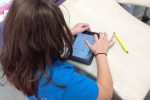Flipping The Classroom
Since Sal Khan started to record his lecture videos on his computer, the world has gotten excited about the potential to flip the classroom. To flip, teachers can use an application like ShowMe or screen record from their SmartBoard but as Khan has pointed out the analytics need to be attached so that teachers can gauge what students know and don’t know. So he has, with the help of his team of developers, put together software to help teachers create a more personalized educational experience. The software, as referenced by the 60 Minutes episode, would allow teachers to create different problems on different levels of difficulty and allow teachers to focus on the individual needs of students. For now, I guess it is in the beta testing and in some schools on the West Coast but with the ShowMe app, teachers can begin to flip their classrooms and utilizing Socrative and Google Forms develop the analytics to help you determine what your students know and are able to do well. So what is preventing people from flipping their classroom? Here are some of the reasons: (This is my own reflection, not scientific)
1. Resources: some people may not have access to iPads or SmartBoards to begin the process of flipping their classroom. As we read about various budget restraints such as the property tax cap, districts are attempting to figure out how to do more with less which may mean delaying the purchase of iPads or other technology for their teachers. Besides money and access, time is other factor. Teacher schedules are booked solid and may not afford them with the time to develop these types of lessons. Besides the schedule aspect, it takes a lot of time to develop lessons and assessments, time that teachers do not have so experimenting with technology may be difficult. Further with Common Core, most districts are rewriting and realigning curriculum to meet the demands of the Common Core.
2. Experience: I know that it is a paradigm change and without some manual that walks teachers through it or without Education courses in universities, teaching the flipping model some people may not be comfortable with the model especially since you would have to plan backwards and utilize programs like Socrative or Google Forms to collect formative data. The data then can allow for differentiation and creating an enriching experience for students. Also research for the model may not yet exist, which may in turn keep people from using the model.
3. It is math and science centric. I have heard from different people that say that flipping can only be done in skill-based courses. This remains to be seen as more of Khan’s videos and the ShowMe community are developed about various topics that are not skilled-based.
4. What do I do in class if I am recording my lectures the night before? The answer, anytime that I am asked this question, is whatever you want. You can use simulations, problem-solving or seminars or whatever else that maybe interactive but somehow connected to the lecture videos. This is where the experience of the teacher comes into play and the analytics come into play; you may determine that a good percentage of your students already know the material so rather than simply reteach maybe you explore a topic in a deeper or meaningful way. I have struggled with this question and have had to think about ways to integrate the app and develop a day-to-day lesson plan for courses that are not problem-based.
5. Where do I find the technology? I know that some people have asked me, “well I have an iPad but which app do I use or how do I do this once I have the app or can I do this with a computer?” There are several options in the app store, which I will not review here but I think the applications that are intuitive and simple to use gain the most traction because most people do not want to deal with app crashes, or computer crashes. Most people want to use the application and upload their video and be done; if applications crash then users lose confidence and decide “Oh, well I have been doing it before the iPad arrived” or turn to other applications that maybe more intuitive. To the second part of the statement, I think that is where a blog like this one helps with the professional development aspect of using applications like ShowMe and having varying skill levels of users explain the various methods being used to teach a lesson and assess the lesson. To the third part of the statement, I know some applications offer the opportunity to develop your own lesson videos, for instance SmartBoard. If you have a SmartBoard in your classroom, you can develop these same videos in your classroom, but you have to upload them to YouTube or some video sharing site that maybe blocked by your network. And for your students this means that they are watching your lesson at home rather than on their smartphone on their way home on the school bus or on their way to a sporting event or in the library during a free period. Not to mention you need a microphone attached to the SmartBoard to develop the video. This is why apps, like ShowMe, make recording your lessons simple, easy and students can watch them anywhere.
I know from my experience students are more willing to participate and tend to perform better in the classroom. Also, by the flipping the classroom, I noticed that my students came into class with prior knowledge that could not have been obtained by reading chapters of a textbook and they came into class with more confidence knowing that we would be digging deeper and exploring various concepts. This in turn made learning visible allowing to wrestle with concepts and gain a deeper understanding of the material.



